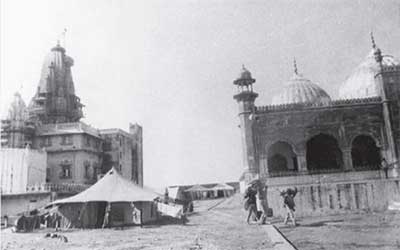Daily-current-affairs /
28 Oct 2020
Place of Worship Act : Daily Current Affairs

Place of Worship Act
Why in NEWS ?
- Sunni Waqf Board seeks implementation of Place of Worship Act amid calls to reclaim
Kashi, Mathura.
About
- Expressing concern over Kashi and Mathura temples being dragged into legal dispute
a year after the Supreme Court’s Ayodhya verdict, the Sunni Central Waqf Board has
sought strict implementation of the Places of Worship Act.
- A plea filed by a Hindu organisation in June had challenged Section 4 of the law in a
bid to open the litigation route to reclaim disputed religious sites other than the Ram
Janmabhoomi in Ayodhya.
- The Vishwa Bhadra Pujari Purohit Mahasangh’s plea assumes significance in the case
of Kashi and Mathura where two disputed mosques stand.
- Chairman of Sunni Central Waqf Board, Zufar Farooqui, said, “The Places of Worship
Act clearly prohibits the conversion of any place of worship and maintain its religious
character as it existed on 15 August, 1947.”
- “The board will be dealing with the court cases but since the places of worship act in
place, it must be implemented to stop such attacks on mosques in India,” he added.
- After a protracted legal tussle, the Supreme Court, on November 9 last year, ruled in
favour of the construction of a Ram temple at the disputed site in Ayodhya and
directed the Centre to allot an alternative five-acre plot to the Sunni Waqf Board for
building a new mosque at a “prominent” place in the holy town in Uttar Pradesh.
The Places of Worship (Special Provisions) Act
- The Act was passed in September 1991, over a year before the demolition of theBabri Masjid (1992).
- The Places of Worship (Special Provisions) Act, 1991 provides for maintaining the
“religious character” of holy structures as it existed on August 15, 1947.
- In its Ayodhya judgment, the Supreme Court commended the enactment of Places
Of Worship Act, 1991 as one that preserved the constitutional value of secularism by
not permitting the status of a place of worship to be changed.
Objective of the Act
- To freeze the status of any place of worship as it existed on August 15, 1947.
- To provide for the maintenance of the religious character of such a place of worship
as on that day.
- To pre-empt new claims by any group about the past status of any place of worship
and attempts to reclaim the structures or the land on which they stood.
- The Act also imposes a positive obligation on the State to maintain the religious
character of every place of worship as it existed at the time of Independence.
- This legislative obligation on the State to preserve and protect the equality of all
faiths is an essential secular feature and one of the basic features of the Indian
Constitution.
Main Features of the Act
- The Act declares that the religious character of a place of worship shall continue to
be the same as it was on August 15, 1947.
- It says no person shall convert any place of worship of any religious denomination
into one of a different denomination or section.
Exceptions
- These provisions will not apply to monuments and sites covered by the Ancient
Monuments and Archaeological Sites and Remains Act, 1958; a suit that has been
finally settled or disposed of; and any dispute that has been settled by the parties or
conversion of any place that took place by acquiescence before the Act commenced.
- Section 5 says that the Act does not apply to the place of worship commonly
referred to as Ram Janmabhoomi-Babri Masjid in Ayodhya.
Penal Provision
- The Act provides for imprisonment up to three years and a fine for anyone
contravening the prohibition.








